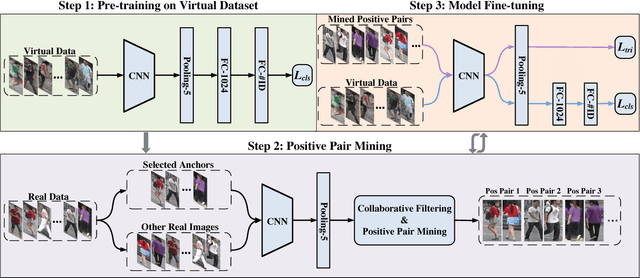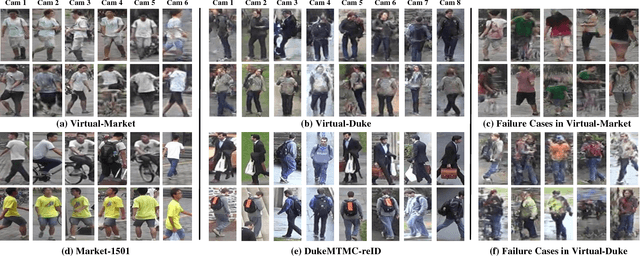Sheng Lian
AD-Det: Boosting Object Detection in UAV Images with Focused Small Objects and Balanced Tail Classes
Apr 08, 2025Abstract:Object detection in Unmanned Aerial Vehicle (UAV) images poses significant challenges due to complex scale variations and class imbalance among objects. Existing methods often address these challenges separately, overlooking the intricate nature of UAV images and the potential synergy between them. In response, this paper proposes AD-Det, a novel framework employing a coherent coarse-to-fine strategy that seamlessly integrates two pivotal components: Adaptive Small Object Enhancement (ASOE) and Dynamic Class-balanced Copy-paste (DCC). ASOE utilizes a high-resolution feature map to identify and cluster regions containing small objects. These regions are subsequently enlarged and processed by a fine-grained detector. On the other hand, DCC conducts object-level resampling by dynamically pasting tail classes around the cluster centers obtained by ASOE, main-taining a dynamic memory bank for each tail class. This approach enables AD-Det to not only extract regions with small objects for precise detection but also dynamically perform reasonable resampling for tail-class objects. Consequently, AD-Det enhances the overall detection performance by addressing the challenges of scale variations and class imbalance in UAV images through a synergistic and adaptive framework. We extensively evaluate our approach on two public datasets, i.e., VisDrone and UAVDT, and demonstrate that AD-Det significantly outperforms existing competitive alternatives. Notably, AD-Det achieves a 37.5% Average Precision (AP) on the VisDrone dataset, surpassing its counterparts by at least 3.1%.
ATM-Net: Anatomy-Aware Text-Guided Multi-Modal Fusion for Fine-Grained Lumbar Spine Segmentation
Apr 04, 2025Abstract:Accurate lumbar spine segmentation is crucial for diagnosing spinal disorders. Existing methods typically use coarse-grained segmentation strategies that lack the fine detail needed for precise diagnosis. Additionally, their reliance on visual-only models hinders the capture of anatomical semantics, leading to misclassified categories and poor segmentation details. To address these limitations, we present ATM-Net, an innovative framework that employs an anatomy-aware, text-guided, multi-modal fusion mechanism for fine-grained segmentation of lumbar substructures, i.e., vertebrae (VBs), intervertebral discs (IDs), and spinal canal (SC). ATM-Net adopts the Anatomy-aware Text Prompt Generator (ATPG) to adaptively convert image annotations into anatomy-aware prompts in different views. These insights are further integrated with image features via the Holistic Anatomy-aware Semantic Fusion (HASF) module, building a comprehensive anatomical context. The Channel-wise Contrastive Anatomy-Aware Enhancement (CCAE) module further enhances class discrimination and refines segmentation through class-wise channel-level multi-modal contrastive learning. Extensive experiments on the MRSpineSeg and SPIDER datasets demonstrate that ATM-Net significantly outperforms state-of-the-art methods, with consistent improvements regarding class discrimination and segmentation details. For example, ATM-Net achieves Dice of 79.39% and HD95 of 9.91 pixels on SPIDER, outperforming the competitive SpineParseNet by 8.31% and 4.14 pixels, respectively.
MHAF-YOLO: Multi-Branch Heterogeneous Auxiliary Fusion YOLO for accurate object detection
Feb 07, 2025Abstract:Due to the effective multi-scale feature fusion capabilities of the Path Aggregation FPN (PAFPN), it has become a widely adopted component in YOLO-based detectors. However, PAFPN struggles to integrate high-level semantic cues with low-level spatial details, limiting its performance in real-world applications, especially with significant scale variations. In this paper, we propose MHAF-YOLO, a novel detection framework featuring a versatile neck design called the Multi-Branch Auxiliary FPN (MAFPN), which consists of two key modules: the Superficial Assisted Fusion (SAF) and Advanced Assisted Fusion (AAF). The SAF bridges the backbone and the neck by fusing shallow features, effectively transferring crucial low-level spatial information with high fidelity. Meanwhile, the AAF integrates multi-scale feature information at deeper neck layers, delivering richer gradient information to the output layer and further enhancing the model learning capacity. To complement MAFPN, we introduce the Global Heterogeneous Flexible Kernel Selection (GHFKS) mechanism and the Reparameterized Heterogeneous Multi-Scale (RepHMS) module to enhance feature fusion. RepHMS is globally integrated into the network, utilizing GHFKS to select larger convolutional kernels for various feature layers, expanding the vertical receptive field and capturing contextual information across spatial hierarchies. Locally, it optimizes convolution by processing both large and small kernels within the same layer, broadening the lateral receptive field and preserving crucial details for detecting smaller targets. The source code of this work is available at: https://github.com/yang0201/MHAF-YOLO.
Leveraging Virtual and Real Person for Unsupervised Person Re-identification
Nov 05, 2018



Abstract:Person re-identification (re-ID) is a challenging problem especially when no labels are available for training. Although recent deep re-ID methods have achieved great improvement, it is still difficult to optimize deep re-ID model without annotations in training data. To address this problem, this study introduces a novel approach for unsupervised person re-ID by leveraging virtual and real data. Our approach includes two components: virtual person generation and training of deep re-ID model. For virtual person generation, we learn a person generation model and a camera style transfer model using unlabeled real data to generate virtual persons with different poses and camera styles. The virtual data is formed as labeled training data, enabling subsequently training deep re-ID model in supervision. For training of deep re-ID model, we divide it into three steps: 1) pre-training a coarse re-ID model by using virtual data; 2) collaborative filtering based positive pair mining from the real data; and 3) fine-tuning of the coarse re-ID model by leveraging the mined positive pairs and virtual data. The final re-ID model is achieved by iterating between step 2 and step 3 until convergence. Experimental results on two large-scale datasets, Market-1501 and DukeMTMC-reID, demonstrate the effectiveness of our approach and shows that the state of the art is achieved in unsupervised person re-ID.
 Add to Chrome
Add to Chrome Add to Firefox
Add to Firefox Add to Edge
Add to Edge